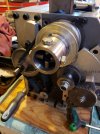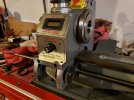I can't even remember any PSAT or SAT scores in the 70s I might have made just about 50 years ago, (<
Wish I could, but the years have taken their toll on remembering that sort of stuff. 
),
but I have to admit that I did make a homemade chicken pot pie tonite out of leftover cooked chicken, a can with some mixed veggies & a can of Cream of Chicken soup all mixed together as a filling, with a home made crust made out of 2 cups all purpose flour, 1/3 cup oil, 2/3 cup milks mixed together & then rolled out on wax paper in two parts. One, about 3/5ths being the base crust & the other 2/5ths being the top crust.
Put the filling in the base, and put the top on, crimped, slit & poked some holes it it for steam relief, & then stuck in the oven that was temping up as I made the pie to 375° F.
Put it in for 30 minutes & a chicken pot pie came out 5/5ths.

Unfortunately there is only 2/5ths left , as my Missus ate 1/5th, and them took another 1/5th for lunch tomorrow & my youngest son stopped by and grabbed another fifth of pie for his 11-7 shift. For some reason the pie got cut into 5ths, instead of 1/4s, 1/6ths 1/8ths, or 1/3rds. I like to think it is because the pot pies I make are homemade & pretty tasty.

Anyway, I might get my arithmetic "off", (
as well as making "{typos") once in a while but I make a damn good Pot pie and I mean well.

Ooops.. Uh oh... A couple 5ths of Thread drift.
My apologies to anyone who might be troubled by my "ramble" in this post LOL

Maybe I should go have one of those 5ths of pie that are left.



